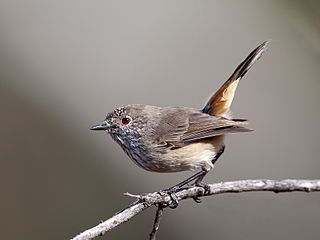
Baillon's crake, also known as the marsh crake, is a small waterbird of the family Rallidae.

The black bittern is a bittern of Old World origin, breeding in tropical Asia from Pakistan, India, Bangladesh and Sri Lanka east to China, Indonesia, and Australia. It is mainly resident, but some northern birds migrate short distances.

The yellow thornbill, formerly known as the little thornbill, is a tiny passerine bird endemic to the eastern coast of Australia. While currently listed as Least Concern by the IUCN, the general consensus is that the population is decreasing.

The brown thornbill is a passerine bird usually found in eastern and south-eastern Australia, including Tasmania. It can grow up to 10 cm (3.9 in) long, and feeds on insects. It is brown, grey and white. The species has five subspecies.

The yellow-rumped thornbill is a species of passerine bird from the genus Acanthiza. The genus was once placed in the family Pardalotidae but that family was split and it is now in the family Acanthizidae. There are four subspecies of yellow-rumped thornbill. It is a small, brownish bird with a distinctive yellow rump and thin dark bill. It inhabits savannah, scrub and forests across most of Australia and eats insects. The species engages in cooperative breeding.

The yellow-tufted honeyeater is a passerine bird found in the south-east ranges of Australia. A predominantly black and yellow honeyeater, it is split into four subspecies.

Hampton is an interim Australian bioregion located in southeastern coastal Western Australia, with a small portion (4%) extending into adjacent South Australia. It has an area of 1,088,198 hectares. The Hampton bioregion is part of the Coolgardie woodlands ecoregion.

The buff-rumped thornbill is a small passerine bird species belonging to the genus Acanthiza, most of which are endemic to Australia. Measuring 8–10 cm in length, this unassuming thornbill is characterised by its plain greenish brown upperparts and very pale-yellow underparts, with a distinctive buff coloured rump. The tail has a broad, blackish band with a paler tip. Adults possess white irises, whilst juveniles have dark eyes. The buff-rumped thornbill is one of 14 species within the genus Acanthiza genus, which are recognisable by their thin, pointed bill. Species are unique in their plumage and distribution. Despite their shared name, the genus is not related to hummingbirds.

The inland thornbill was originally described by English ornithologist John Gould in The Birds of Australia. Inland thornbills are within the order passerines. The inland thornbill belongs to the genus Acanthiza, which now has three more species than the eleven outlined by Gould in The Birds of Australia. The Noongar people of southwestern Western Australia call A. apicalis "Djoobi-Djoolbang". The inland thornbill is also known as the broad-tail thornbill and presently contains several subspecies that were once considered independent species. The word apicalis comes from the Latin for 'tipped'.

The Tasmanian Thornbill is a small bushland member of the Acanthizidae family, endemic to Tasmania and the Bass Strait Islands. It is a common bird in these regions and is often found occupying the colder, wetter portions of them. The brown thornbill will typically occupy the correspondingly drier portions of habitat.

The striated thornbill is a species of bird in the family Acanthizidae. It is endemic to Australia, where its natural habitat is subtropical or tropical dry forests.

The chestnut-rumped thornbill is a small passerine bird in the family Acanthizidae, endemic to Australia.

The speckled warbler is a species of bird in the family Acanthizidae. It is endemic to eastern Australia. Its natural habitat is temperate forests.

The rufous bristlebird is one of three extant species of bristlebirds. It is endemic to Australia where three subspecies have been described from coastal southwestern Western Australia, southeastern South Australia and southwestern Victoria. Its natural habitat is coastal shrublands and heathlands. It is threatened by habitat destruction.

The western yellow robin is a species of bird in the Australasian robin family, Petroicidae, native to Australia. Described by John Gould in 1838, the western yellow robin and its Australian relatives are not closely related to either the European or American robins, but they appear to be an early offshoot of the Passerida group of songbirds. Ranging between 13.5 and 15.5 cm long, it has grey upperparts, and a grey breast and head, broken by whitish streaks near the bill and below the eye, with a conspicuous yellow belly. The sexes are similar in appearance. Two subspecies are recognized: subspecies griseogularis, which has a yellow rump, and subspecies rosinae with an olive-green rump.

The chestnut-rumped heathwren is a species of bird in the family Acanthizidae. It is endemic to temperate and subtropical forests and heathlands of Australia.

The crested bellbird is a medium-sized passerine bird in the family Oreoicidae. It is native to drier parts of Australia where its typical habitats are acacia scrublands, eucalypt woodlands, spinifex and saltbush plains, and dunes. The male is about 20 cm (8 in) long and has a grey head, a black crest and breast, and a grey or olive brown body. The female and juvenile are similar but the colours are more muted and the black breast is lacking. The distinctive call is a high pitched bell-like sound, audible at some distance. Sometimes a pair of birds duet.

The grey-crowned babbler is a species of bird in the family Pomatostomidae. They are found in Australia and New Guinea . Its habitats include tropical and subtropical dry broadlife forests, tropical moist lowland forests, shrublands, and savannas.

The redthroat is a small, mostly ground-dwelling species of bird in the family Acanthizidae. It is endemic to Australia, occurring mostly in arid and semi-arid areas containing acacia and chenopod shrublands. The species has a distinctive red throat patch and is able to mimic the calls of numerous other bird species.

Gawler is an interim Australian bioregion located in South Australia. It has an area of 12,002,883 hectares. Gawler bioregion is part of the Tirari–Sturt stony desert ecoregion.





















